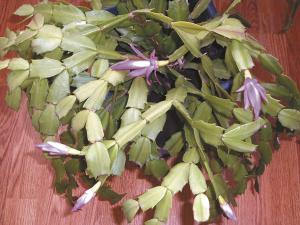Christmas cacti may become living heirlooms
Tis the season to bring a hostess gift, that small token of thanks that you give to whoever throws a party, cooks a dinner or offers a bed. One of the most fitting hostess gifts is a living, blooming plant that itself lives on a host, the Christmas cactus.
These plants are members of the Zygo-cactus family, native to the tropics rather than the true cactus that is native to many deserts. As an epiphyte, these are the perfect guest. The word epiphyte comes from the Greek words epi meaning upon and phyton meaning plant, so an epiphyte grows on another plant, but isn’t a parasite and doesn’t suck nourishment out of the host. Natives of the Americas, Christmas cacti naturally grow in the forks of tree limbs and live off decaying leaves, natural rubble and scraps that end up there. Because they are truly tropical plants, Christmas cactus need very different care from true cacti. Christmas cactus blooms in red, white, cream, pink, orange and even fuchsia.
So here is how to be a good host to these colorful holiday guests. The low care and long life of Christmas cacti mean that many become living heirlooms, passed down from generation to generation.
To get your Christmas cactus plants to bloom for the holidays, they need proper light exposure, even temperatures and restricted watering. As summer fades into autumn, around September and October, move your Christmas cactus plants to a cool room with an even temperature right near 50 degrees. They are easily killed by freezing temperatures and will only bloom if exposed to proper levels of light.
Place them where they get indirect bright light during the day but complete darkness at night. They only bloom when they get 12 to 14 hours of darkness. This is similar to how to treat a poinsettia except poinsettias need warm temperatures, and your Christmas cactus needs to be at about 50 degrees.
Like all tropical plants, a Christmas cactus needs deep watering that soaks all the soil, followed by a dry period. Only water again after the top inch of soil is dry. Cut way back on the watering during the fall and winter to encourage more blooms.
For best results, keep humidity around 50 or 60 percent. Try setting your Christmas cactus on a tray of pebbles filled with water that does not touch the pot. You can even spritz the plants with a mister a few times a week. Christmas cactus should be kept away from doors, hallways or drafty windows. Too hot is as bad as too cold, so give them room away from heating ducts and fireplaces.
Feed Christmas cactus once in late October or early November with a diluted organic liquid fertilizer for blooming houseplants. Feed them again in late February. When they are actively growing during the summer months, feed them regularly with the same organic liquid fertilizer. Take care to avoid high-nitrogen fertilizers, as these will encourage leaf growth, but no flowers.
In spite of your best efforts, your Christmas cactus will sometimes develop flower buds, but instead of blooming, let the buds drop off the plant. Usually bud drop is from over-watering, too low humidity or not enough light. After your Christmas cactus is done blooming, let it rest for about a month. Set it in a cool room and cut way back on watering. It may drop a leaf or two while resting.
Most plants bloom best when slightly pot bound, but if you need to move your Christmas cactus to a bigger pot, do it just before growth starts in March or early April. Try a potting mix that is about half potting soil and half fine bark, like what is sold for orchids.
If your Christmas cactus is given proper care and is placed in the right location, it’s not unusual for it to flower several times throughout the year.
Once you have your own Christmas cactus, it is easy to create new plants. Simply cut or snap off a stem and let it dry out in the shade for two or three days to form a callous on the cut end. Make sure each cutting has at least two or three segments or joints on it.
Plant your cuttings in a mixture of 50 percent sand and 50 percent sterile potting soil. Since roots form at the bottom of each segment, be sure that at least half of the lower segment is fully under ground. Water only when the soil feels dry. Keep the potted cuttings in a warm spot out of direct sun, but in bright light. Before they can grow roots, cuttings sometimes wilt dramatically, so water regularly, taking care to let the soil dry out between waterings.
So welcome Christmas cactus as your guest, and with a little care, you can have a long-lived plant. Take some cuttings, and you can spread the cheer around. You may cut back on mailing greeting cards and bake fewer trays of cookies, but like every celebration, your Christmas cactus will just get larger and showier each year.





















































